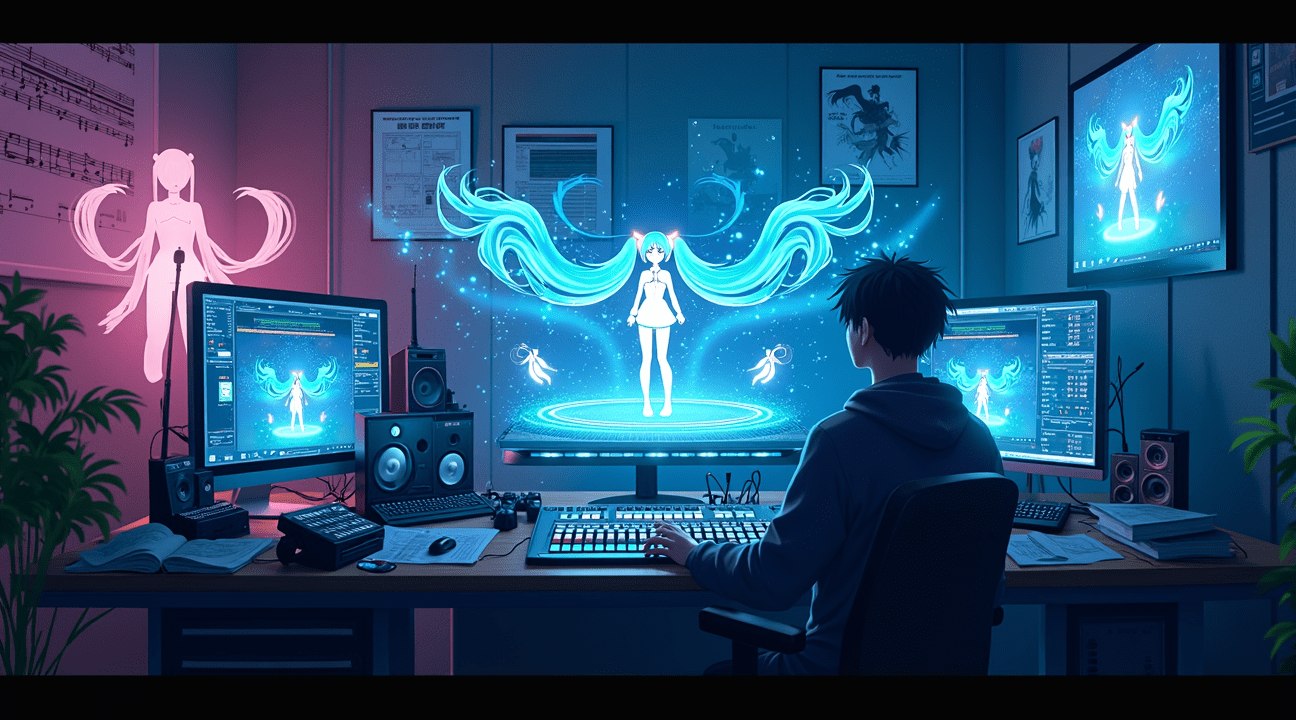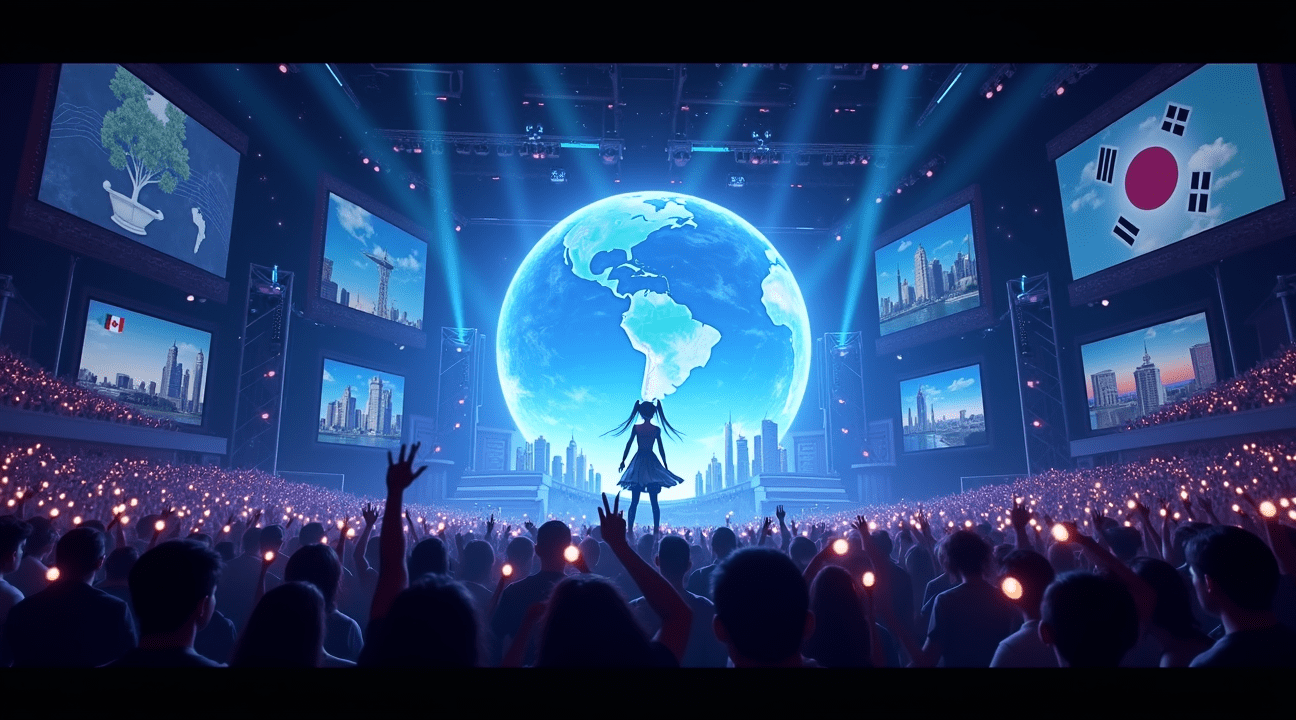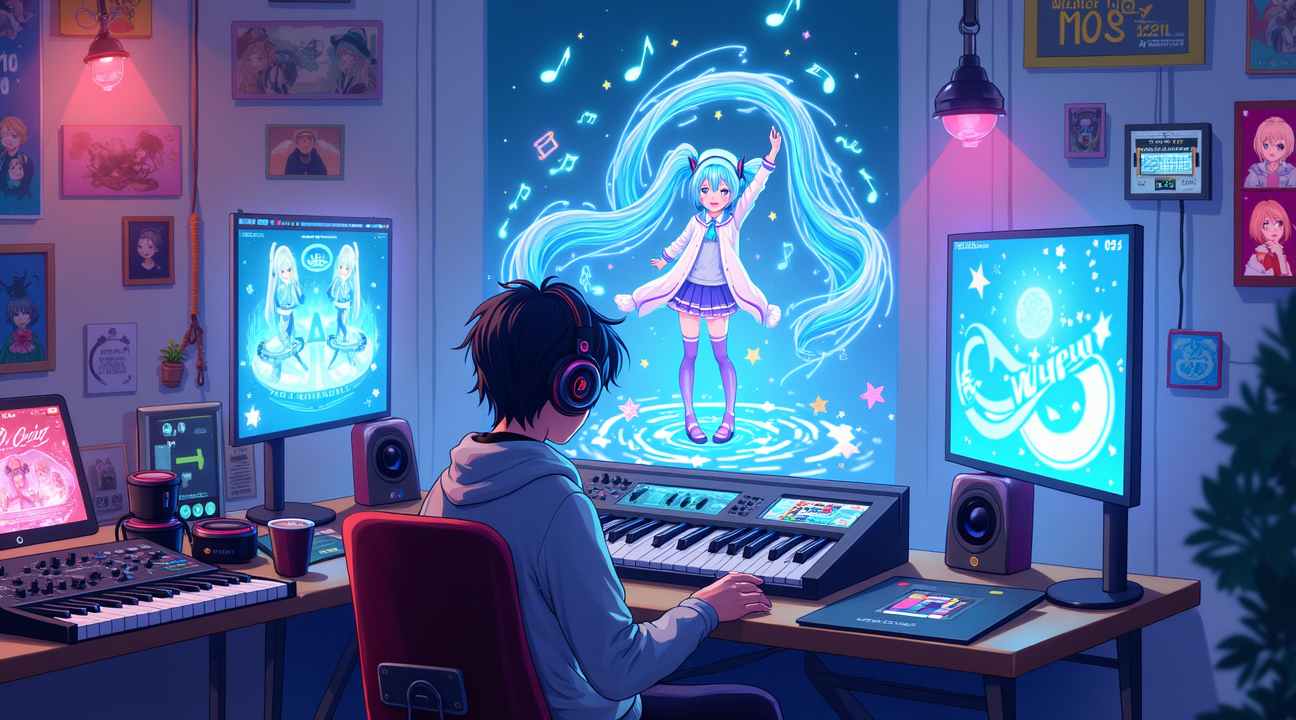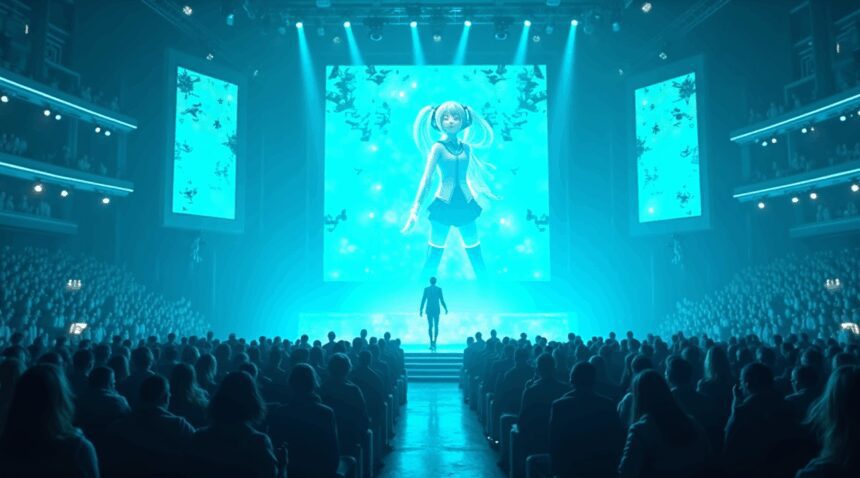Hatsune Miku has fundamentally transformed the music industry by enabling the creation of over 100,000 original songs through democratized music production technology. This virtual singer has evolved from a Japanese software tool into a global cultural phenomenon that redefined how music gets created, shared, and experienced across international markets.
Key Takeaways
- Unprecedented Creative Output: Over 100,000 original songs have been created using Hatsune Miku’s voice, representing the largest scale of user-generated music content in history and fundamentally changing the creative landscape.
- Global Market Dominance: 59% of Vocaloid music streaming shares now originate outside Japan, with significant adoption in the United States, South Korea, Brazil, Mexico, and other international markets.
- Industry Breakthrough Success: Exit Tunes Presents Vocalogenesis feat. Hatsune Miku became the first Vocaloid album to top Japan’s Oricon chart, proving virtual performers can compete directly with traditional artists.
- Revolutionary Technology Access: Vocaloid software democratized music production by eliminating traditional barriers like expensive studio time and professional vocalists, enabling bedroom producers to create professional-quality tracks.
- Virtual Concert Innovation: Miku pioneered VR concerts that eliminate geographical barriers and venue capacity limitations, influencing how the entire entertainment industry approaches live performances and audience engagement.
How a Digital Singer Created Over 100,000 Songs and Changed Music Forever
I’ve witnessed something extraordinary unfold in the music industry since Hatsune Miku’s debut – a complete transformation of how music gets created, shared, and discovered. The numbers tell a remarkable story: over 100,000 original songs have been created using Hatsune Miku’s distinctive voice, representing an unprecedented scale of user-generated music content that has fundamentally altered the creative landscape.
The commercial success started immediately. By July 2008, more than 40,000 units of her Vocaloid software had been sold, averaging 300 units per day within the first year of release. This rapid adoption signaled something much larger than a simple software launch – it marked the birth of a new creative ecosystem where anyone with musical ideas could produce professional-sounding tracks without traditional barriers.
The Quantity-Based Attention Revolution
Hatsune Miku spearheads what I call a quantity-based attention economy where the sheer volume of music enables emerging artists to receive exposure without traditional industry limitations. Unlike conventional music production that requires significant investment in studio time, professional singers, and record label backing, Miku’s platform democratizes music creation. Bedroom producers and aspiring composers can now craft complete songs with a virtual vocalist who never gets tired, never demands payment, and remains available 24/7.
This massive output creates a unique discovery mechanism. When thousands of new Miku songs appear daily across platforms like Nico Nico Douga and YouTube, listeners develop sophisticated filtering systems based on view counts, community recommendations, and viral sharing. The revolution in music production has fundamentally changed how audiences find new tracks, moving away from radio gatekeepers and toward community-driven curation.
Legendary Tracks that Defined a Movement
Several standout compositions demonstrate the creative heights achievable through this digital collaboration:
- ‘Rabbit Hole’ by DECO*27 – Sophisticated electronic production with Miku’s ethereal vocals, creating an atmospheric piece that resonates with millions.
- ‘Lost One’s Weeping’ by Neru – A powerful emotional track with darker themes and aggressive instrumentation, showing that virtual vocalists can express deep human experiences.
- ‘MikuMiku ni Shite Ageru’ – One of the first songs to enter Nico Nico Douga’s prestigious ‘Hall of Fame’ and ‘Hall of Legends’. With catchy melodies and strong visual appeal, it became a cultural touchstone.
The song ‘MikuMiku ni Shite Ageru’ established the template for viral Miku content: catchy melodies, memorable lyrics, and visual elements that invite fan participation. Its success demonstrated that virtual performers could have the same cultural impact as traditional artists, leading to countless covers, remixes, and fan interpretations.
The ripple effects extend far beyond individual tracks. These viral sensations have influenced AI in music production and inspired major record labels to reconsider their approach to talent discovery. Artists who gain recognition through Miku collaborations often transition to mainstream success, bringing with them the experimental spirit fostered in the virtual music space.
This transformation represents more than technological novelty – it’s a fundamental shift in musical authorship and audience participation. Fans don’t just consume Miku content; they actively shape its evolution through remixes, covers, and derivative works. This participatory culture has created a powerful influence on modern entertainment, blurring the line between artist and audience.
The legacy of these 100,000+ songs extends beyond their individual merits. They’ve created a new model for artistic collaboration where human creativity fuses with digital tools to produce outcomes impossible through traditional means. Each track adds to a growing library that offers inspiration, serves as reference material, and stands as proof of concept for future creators embracing this hybrid approach to music-making.
Watch a few landmark Hatsune Miku performances and fan-made hits to see the phenomenon in motion:
https://www.youtube.com/watch?v=DTXO7KGHtjI
https://www.youtube.com/watch?v=5cY5DghwGvg
https://www.youtube.com/watch?v=Sbz_mIGoMb4
The Technology That Democratized Music Production
Behind Hatsune Miku’s turquoise twin-tails lies revolutionary technology that fundamentally changed how music gets created. I’ve witnessed how the Vocaloid software developed by Crypton Future Media opened doors that traditional music production kept firmly locked. The voice that brings Miku to life comes from Japanese actress Saki Fujita, whose vocal samples were carefully processed to create a digital singer capable of performing any song imaginable.
The Vocaloid ecosystem breaks down barriers that once separated amateur creators from professional musicians. Unlike traditional recording processes that require expensive studio time, professional vocalists, and industry connections, this technology puts complete song creation into individual hands. Anyone with a computer and the software can compose melodies, write lyrics, and produce finished tracks featuring Miku’s distinctive voice.
Internet platforms transformed this technological capability into a creative revolution. Nico Nico Douga emerged as the primary hub where thousands of Miku songs and accompanying music videos found their audience. This platform didn’t just host content – it fostered a participatory culture where creators could build upon each other’s work, remix existing songs, and collaborate across geographical boundaries. Global phenomenon status came naturally as creators worldwide contributed to an ever-expanding library of Miku content.
From Bedroom Studios to Billboard Charts
The democratizing effect of Vocaloid technology becomes most apparent through success stories of artists who started in their bedrooms and reached professional heights. Consider these breakthrough examples:
- Yonezu Kenshi began creating music under the alias Hachi, producing Vocaloid tracks that garnered millions of views before transitioning to mainstream J-pop stardom
- Wowaka crafted emotionally charged rock compositions featuring Miku that resonated across demographics and established him as a respected composer
- Supercell transformed from a Vocaloid music circle into a commercially successful group, proving that Internet-born creativity could translate into traditional music industry success
- Livetune pioneered electronic music techniques through Miku collaborations that influenced broader electronic music trends
- 19’s Sound Factory demonstrated how collective creativity could flourish when barriers to entry disappeared
This participatory ecosystem challenges traditional gatekeeping mechanisms that historically controlled music production and distribution. Sampling in music techniques that once required extensive resources became accessible to individual creators working with Vocaloid technology.
The collaborative nature of Miku’s community extends beyond individual success stories. Creators regularly build upon existing works, creating covers, remixes, and entirely new interpretations of popular Vocaloid songs. This remix culture exemplifies how AI in music technology can foster creativity rather than replace human artistic expression.
Professional musicians increasingly recognize Vocaloid’s legitimacy as both a creative tool and cultural force. Studios now hire former Vocaloid producers, record labels scout talent from Nico Nico Douga, and mainstream artists collaborate with creators who built their reputations through Miku productions. The technology that began as a niche software tool evolved into a pipeline for discovering and developing musical talent.
The ripple effects extend beyond individual careers to influence broader music industry practices. Record labels study Vocaloid communities to identify trending sounds and emerging artists. Concert promoters organize live events featuring Vocaloid music, complete with holographic performances that blur lines between virtual and physical entertainment. Pop culture impact manifests through merchandise, media appearances, and cross-industry collaborations that treat Miku as both technological innovation and cultural icon.
The democratization process continues expanding as technology becomes more accessible and user-friendly. Modern Vocaloid iterations offer improved voice quality, easier interfaces, and enhanced creative capabilities that lower technical barriers even further. Educational institutions incorporate Vocaloid software into music curricula, introducing new generations to production techniques that were once exclusively professional domains.

From Japan to the World: Miku’s Global Domination
The statistics tell a remarkable story about Hatsune Miku’s journey from a Japanese virtual singer to a worldwide phenomenon. Today, 59% of streaming shares for Vocaloid music originate outside Japan, demonstrating how this digital character has transcended cultural boundaries to capture hearts across continents.
International Markets Embrace the Virtual Superstar
Key international markets have emerged as powerhouses for Vocaloid content consumption. The United States leads Western adoption, while South Korea, Indonesia, and Taiwan represent significant Asian markets outside Japan. These regions show sustained growth in both listener engagement and content creation, proving that Miku’s appeal isn’t limited by language barriers or cultural differences.
Mexico and Brazil showcase particularly impressive numbers, with over 60% of Vocaloid tracks streamed featuring Hatsune Miku specifically. This Latin American embrace highlights how pop culture influences can cross linguistic and geographic boundaries when the core concept resonates with audiences. Brazilian and Mexican fans have created vibrant communities that produce original content, translations, and local events celebrating the virtual idol.
Mainstream Recognition and Festival Performances
Miku’s scheduled appearances at Coachella in both 2020 and 2024 represent a watershed moment for virtual performers in Western mainstream music. Though the 2020 performance was canceled due to global events, the booking itself signaled that major festival organizers recognize Miku’s draw and cultural significance. Coachella’s interest demonstrates how AI in music has evolved from niche curiosity to legitimate entertainment option.
This mainstream crossover recognition extends beyond festivals. Music industry professionals now acknowledge virtual performers as viable acts capable of drawing substantial audiences. The technology behind holographic concerts has improved dramatically, making live Miku performances increasingly sophisticated and engaging for audiences unfamiliar with the character’s digital origins.
While South Korea and Taiwan show impressive diversity in their virtual singer preferences, embracing multiple Vocaloid characters and even developing their own digital performers, Miku maintains her position as the global standard-bearer. Her consistent dominance across different markets reflects not just first-mover advantage but sustained innovation in content creation and community engagement.
International producers and musicians actively collaborate on Miku-featuring tracks, creating fusion pieces that blend local musical traditions with the character’s distinctive vocal style. This ongoing creative exchange has enriched both the global music landscape and the Vocaloid ecosystem itself.
The numbers also reveal interesting patterns in consumption habits:
- Western audiences tend to gravitate toward English-language Miku covers and original compositions.
- Asian markets show stronger preference for Japanese content with subtitles.
This diversity in consumption preferences has encouraged creators to produce content in multiple languages, further expanding Miku’s global reach.
Streaming platforms report that Miku-related content consistently outperforms other virtual performers in terms of both play counts and engagement metrics. Her videos generate high levels of comments, shares, and user-generated response content, creating viral loops that extend her influence beyond the immediate fan base.
The global domination extends to merchandise sales, concert attendance, and social media engagement:
- International fans invest heavily in Miku-related products, often importing items directly from Japan.
- Companies have expanded their global distribution networks to meet international demand.
Concert hologram technology continues advancing, making it feasible for Miku to “perform” in multiple countries simultaneously through synchronized events. This technological capability positions her uniquely among entertainers, allowing for global concert tours that would be impossible for human performers due to physical and logistical constraints.
The cultural impact extends beyond entertainment into education and technology discussions. Universities and research institutions frequently reference Miku’s success when studying digital identity, artificial intelligence, and cross-cultural communication. Her influence on anime’s global reach has also contributed to broader Japanese cultural export strategies.

The Cultural Revolution: When Fans Become Creators
Hatsune Miku transformed music creation from a top-down industry model into something radically different – a decentralized playground where anyone with creativity and basic software can become a composer. I’ve watched this shift unfold over the past decade, fundamentally altering how we think about musical authorship and fan participation.
Breaking Down Traditional Barriers
The traditional music industry once required extensive resources, record label backing, and professional studio access. Miku shattered these barriers by offering creators a complete vocal package in software form. Bedroom producers suddenly gained access to a “singer” who never tired, never demanded creative control, and could perform any style imaginable. This democratization mirrors how AI in music continues reshaping the entertainment landscape today.
Fans no longer simply consume content – they actively shape it. The community generates thousands of original songs monthly, with creators serving as composers, lyricists, illustrators, and video producers. This collaborative ecosystem thrives on remix culture, where one person’s melody becomes another’s remix, creating an endless cycle of creative iteration reminiscent of how sampling revolutionized music production decades earlier.
The Vocalo-Native Generation
A fascinating demographic has emerged known as the “Vocalo-native generation” – young people whose first meaningful exposure to pop music came through virtual singers rather than human performers. These individuals grew up in digital spaces where synthetic voices felt completely natural, creating music that reflects their unique perspective on identity and creativity.
This generation approaches music creation differently than their predecessors. They’re comfortable with digital aesthetics, synthetic sounds, and collaborative creation processes that span continents. Their work often explores themes of isolation, digital identity, and human connection in ways that resonate with contemporary pop culture movements.
The cultural impact extends beyond music into visual arts, fashion, and social interaction. Creators use Miku as a canvas for expressing diverse personal perspectives rather than conforming to mainstream market demands. This represents a fundamental shift where individual expression takes precedence over mass appeal, creating a rich tapestry of content that reflects authentic human experiences rather than manufactured trends.
This revolution demonstrates how technology can democratize creative expression while fostering genuine community connections. The traditional gatekeepers of musical taste no longer hold exclusive power when fans possess the tools and platforms to create, share, and celebrate their own artistic visions.

Chart-Topping Albums and Cross-Genre Collaborations
I’ve witnessed Hatsune Miku break musical barriers in ways that seemed impossible just a decade ago. The virtual vocalist’s journey from niche software to mainstream success reached a historic milestone when Exit Tunes Presents Vocalogenesis feat. Hatsune Miku became the first Vocaloid album to claim the top spot on Japan’s prestigious Oricon chart. This achievement marked a turning point that demonstrated AI in music could compete directly with traditional artists.
Breakthrough Albums That Defined an Era
Several albums have cemented Miku’s position as a legitimate musical force. Supercell’s self-titled debut introduced the character to broader audiences through emotionally resonant tracks that showcased the software’s expressive capabilities. Re:package followed with innovative production techniques that pushed Vocaloid technology’s creative boundaries. Miku no Kanzume delivered a carefully curated collection that highlighted diverse producer talents within the community. Wowaka’s Unhappy Refrain stood out for its raw emotional intensity and complex musical arrangements that challenged preconceptions about synthetic vocals.
Each release built upon previous successes while exploring new sonic territories. Producers learned to harness Miku’s unique vocal characteristics rather than simply treating her as a human voice substitute. This approach led to distinctly digital compositions that embraced their artificial origins while maintaining genuine emotional depth.
Modern Cross-Genre Collaborations
Recent years have seen Miku venture into unexpected musical partnerships that demonstrate her versatility across genres.
- In 2022, Ashnikko incorporated Miku into ‘Daisy 2.0’, blending the virtual singer’s ethereal tones with aggressive electronic elements and alternative pop sensibilities. This collaboration introduced Miku to Western audiences who might never have encountered Vocaloid music otherwise.
- Set It Off’s ‘Why Do I’ presented another fascinating fusion, combining Miku’s synthetic vocals with rock instrumentation and punk energy. The track proved that virtual singers could enhance rather than replace human performers, creating hybrid soundscapes that neither could achieve alone.
These partnerships have opened doors for similar experiments across multiple musical styles.
‘Meruto’ by ryo exemplifies Miku’s power to generate viral phenomena that transcend traditional music industry mechanisms. The track spread organically through social media platforms, accumulating millions of views without conventional promotional support. Its success illustrated how revolutionary soundscapes can emerge from unconventional sources and reach global audiences through digital networks.
The song’s viral nature stemmed from its infectious melody combined with Miku’s distinctive vocal delivery. Listeners shared, remixed, and reinterpreted the track across platforms, creating a self-sustaining cycle of engagement that traditional marketing couldn’t replicate. This organic growth pattern has become characteristic of successful Vocaloid releases.
Cross-genre collaborations continue expanding Miku’s influence beyond electronic music into hip-hop, rock, jazz, and even classical compositions.
- Each new partnership challenges both producers and listeners to reconsider their assumptions about artificial intelligence’s role in creative expression.
- The virtual singer’s ability to adapt her vocal style to different genres while maintaining her distinctive character has proven invaluable for artists seeking fresh perspectives.
These developments reflect broader changes in how audiences consume and interact with music. Digital platforms have democratized music distribution while artificial intelligence tools become increasingly sophisticated. Miku represents the convergence of these trends, embodying pop culture’s influence on technological adoption and creative expression.
The success of these albums and collaborations has established Miku as more than a technological curiosity. She’s become a legitimate artistic medium that enables new forms of musical expression while building bridges between human creativity and artificial intelligence capabilities. Her chart-topping achievements prove that audiences are ready to embrace virtual performers when they deliver compelling musical experiences.
Virtual Reality Concerts and the Future of Entertainment
Hatsune Miku blazed a trail in digital entertainment by hosting her own video games and virtual reality concerts, fundamentally changing how audiences experience live performances. Her VR concerts eliminate geographical barriers, allowing fans from Tokyo to New York to attend the same show simultaneously. I’ve witnessed how these innovative performances combine the energy of traditional concerts with cutting-edge digital capabilities, creating experiences that weren’t possible just a decade ago.
The virtual singer’s concerts showcase remarkable technical achievements through holographic projections and immersive environments. Fans don special VR headsets and find themselves standing in fantastical venues that defy physical laws – concert halls floating in space, underwater amphitheaters, or crystalline structures that pulse with the music’s rhythm. These performances demonstrate how AI technology can create entirely new forms of artistic expression.
Breaking Down Physical Barriers
Virtual reality concerts solve several challenges that plague traditional live music events:
- Venue capacity limitations disappear when digital spaces can accommodate unlimited audiences
- Travel expenses and visa restrictions no longer prevent international fans from attending
- Accessibility concerns for disabled fans get addressed through customizable virtual environments
- Time zone differences become manageable with recorded and replay options
- Ticket scalping becomes virtually impossible in properly managed digital platforms
Major entertainment companies have taken notice of Miku’s success and begun implementing similar technologies across their own properties. Disney has experimented with VR concerts for their animated characters, while major record labels invest heavily in virtual performance platforms. The technology that made Miku’s concerts possible now influences everything from music production techniques to how artists interact with their fanbase.
Concert attendance data reveals the massive appeal of these virtual experiences. Miku’s VR concerts regularly attract hundreds of thousands of simultaneous viewers, numbers that would require dozens of stadium shows to achieve through traditional means. I’ve observed how these events generate significant revenue through virtual merchandise, special edition digital items, and premium viewing experiences that offer backstage access to digital environments.
The entertainment industry’s adoption of VR concert technology accelerated significantly during global lockdowns, but Miku had already proven the concept’s viability years earlier. Her virtual performances demonstrated that audiences crave connection and shared experiences, regardless of whether the performer exists in physical form. This insight has shaped how pop culture phenomena develop and maintain their influence in an increasingly digital world.
Gaming platforms have integrated concert experiences directly into their ecosystems, following Miku’s example of blending entertainment mediums. Players can attend virtual concerts within their favorite games, creating social experiences that combine multiple forms of digital entertainment. These hybrid experiences represent the future of how audiences will consume live performances.
The success of Miku’s virtual concerts has also influenced how traditional artists approach their own performances. Major musicians now incorporate holographic elements, interactive digital components, and virtual reality streaming options into their live shows. The technology originally developed for a virtual singer has become standard practice across the entertainment industry.
Production costs for virtual concerts can be significantly lower than traditional touring, making live performance accessible to independent artists who couldn’t afford extensive tour logistics. I’ve seen emerging artists adopt virtual concert platforms to reach global audiences without the massive financial investment traditionally required for international touring.
The data collected from virtual concerts provides unprecedented insights into audience behavior and preferences. Concert organizers can track which songs generate the most engagement, where audiences focus their attention during performances, and how different virtual environments affect the overall experience. This information helps artists and producers create more engaging content tailored to audience preferences.
Virtual reality concerts represent more than just a technological novelty – they’ve fundamentally altered expectations around live entertainment. Miku’s pioneering work in this space continues to influence how the entertainment industry thinks about audience engagement, global reach, and the very definition of what constitutes a live performance in our increasingly connected digital age.
https://www.youtube.com/watch?v=DTXO7KGHtjI
Sources:
Wikipedia: “Hatsune Miku”
NHSJS: “Deconstruction of Music Culture Through Hatsune Miku”
Stanford GSB: “Supercell’s Supercell featuring Hatsune Miku”
Vinyl Me, Please: “The Evolution and Global Impact of Vocaloid Music”
Nippon.com: “Hatsune Miku: Digital Face of a Twenty-First Century Music Scene”
Chromatic Dreamers: “All About Vocaloid, Hatsune Miku & The Producers Behind Her”


